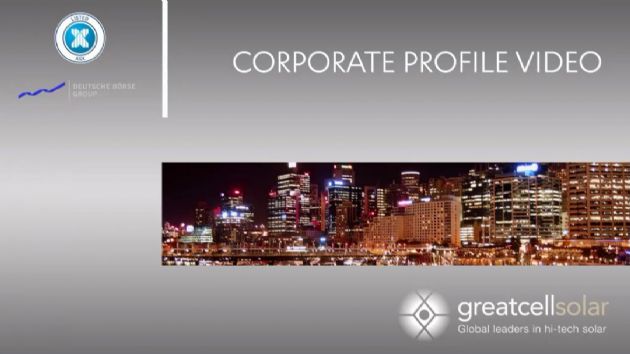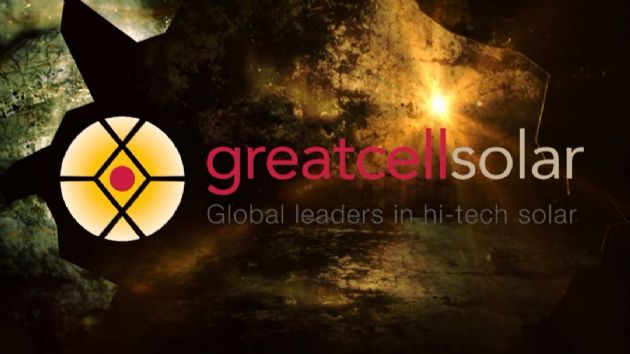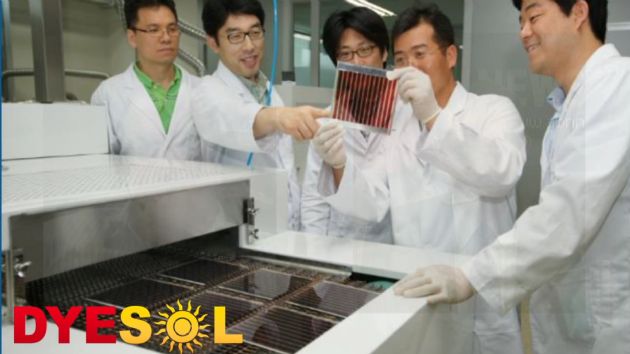 September 2016 Quarterly Report and Appendix 4C
September 2016 Quarterly Report and Appendix 4C
Canberra, Oct 31, 2016 AEST (ABN Newswire) - Dyesol Ltd ( ASX:DYE) (
ASX:DYE) ( DYSOY:OTCMKTS) is pleased to provide the company's Quarterly Report and Appendix 4C for the period ended 30th September 2016.
DYSOY:OTCMKTS) is pleased to provide the company's Quarterly Report and Appendix 4C for the period ended 30th September 2016.
- Dyesol Ranked Top 5 in the 2016 AFR Australian Innovation Awards
- Global Solar PV Business Development Opportunities Improving
- World Economic Forum Ranks Perovskite Solar Cells 4th in Emerging Global Technologies
- Quarterly Technology Advisory Board UV Stability Milestone Achieved
- New Provisional Patent Filed for Hermetically Sealed Devices
- $3.844 Million R&D Tax Rebate for FY2016 Received Post September 30
Corporate and Financial
At Dyesol we are invariably very busy or simply flat-out. At the moment we are flat-out. Why? Well it is difficult to put one's finger exactly on the pulse, however sentiment in the global solar sector has really picked up, the European summer holidays are behind us, the Australian federal government and opposition have reached substantial agreement on important issues such as ARENA funding and our revolutionary PSC technology is making the international headlines, whether it be at the World Economic Forum or in more esoteric scientific journals. Perovskite Solar Cells are coming of age and Dyesol is at the forefront of this exciting technology development.
Quietly, we have once again been progressing business development in Europe. In fact, we have recently signed a (prototype facility/ manufacturing) heads of agreement. However, it will not have any meaningful implications for shareholders until we can confirm the enthusiasm with binding and fully funded contracts of supply and joint manufacture. We have become reasonably experienced in understanding the dynamics of commercial collaboration and the lessons learned mean we take nothing for granted. As they say, "show me the money"! That said, we hope to translate the recent, early stage negotiations into a binding commercial arrangement in the coming months, underpinned by substantial government financial support.
Historically, we have been vastly more successful in attracting financial assistance in Europe than in our own backyard. In our view, the role of government is to help bear the considerable financial risk of scale-up, particularly at the prototype and pilot line stages, where so many aspiring technology companies have come unstuck. Cheap, clean, green energy is in the national interest.
Solliance is also enjoying a similar pick up in interest with European utilities lining up to participate in H2020 projects with Dyesol and obtain a seat at the table. We are always conscious of our significant historical investment in R&D and not overly disposed to providing cheap seats around that table.
The Turks also appear to be resolving their internal issues and lines of communication have been restored after some disarray. Our long-term technology champions at the Development Bank of Turkey have been instrumental in keeping us at the forefront of the Turkish government renewable energy policy agenda and, as we suggested last quarter, there is room for optimism that the very significant project will begin to progress again. To quote recent communication: "The support and incentives for photovoltaics production in Turkey is top now". For us this is an exercise in risk management, with the technology due diligence having completed in May. Most importantly for Dyesol, the portfolio of business development opportunities has broadened such that we should be more resilient in future to geopolitical shocks.
At home, we can report progress in manoeuvres that are bringing Dyesol, government and industry together. The letter of intent with CSIRO is an important step in weaving our way through the miasma of technology commercialisation in Australia. Solar PV development needs substance and momentum and it is important to concentrate our national effort. The task of taking on the Chinese, Americans and Europeans cannot be underestimated and the politicians need to be alert to the challenges of succeeding in the global market place.
Too many times in the past, financial assistance for technology development in Australia has had a disparate and unfocused aspect, with countless, poorly capitalised "start-ups" and too few successes. Government cannot "dine out" on the success of Cochlear and Resmed for ever. Hence, we are somewhat taking charge of our destiny and helping create an environment that we believe will optimise our prospects in Australia and beyond. We have $8.5 million government grants up for consideration in the near future and are increasingly doing this in a co-ordinated way with academic institutions, government and industry.
Research and Development
The quarterly Technology Advisory Board milestone of UV testing of 10% 1 cm2 porous carbon strip cells was met and exceeded. Work began with fabrication of a UV light source compliant with IEC 61646. This system was setup in Dyesol's Dry Room (relative humidity <5%). 1 cm2 Strip Cells were exposed at room temperature. Results demonstrated only 1% - 3% relative loss in efficiency over the required 15 kWh/m2 irradiation time. With the promising results, the exposure temperature was increased to 60 °C, so that the test was fully compliant with IEC 61646 requirements. Again, good stability was achieved with only 5% relative loss in efficiency over the course of the test. PV accreditation is now converging on a common or uniform standard - IEC 61215.
Progress at Solliance, where architectures or material "stacks" are being specifically developed to suit flexible or metals substrates, has been equally successful. The internal milestone for the quarter was to achieve 12% efficiency using a 100% inorganic material configuration - 13.7% was achieved using a planar p-i-n based cell. Rapid progress has been achieved in identifying substitute inorganic HTMs that go towards meeting our requirement of stable, long-life modules. We work closely with Professor Michael Graetzel and EPFL also in this key area of development. Addressing the vast opportunity of BIPV metal roof is our goal and the recent progress is attracting emerging interest from energy utilities and steel companies in Europe.
During the quarter a provisional patent was also filed to protect invention in the area of halide modified surfaces. Assisting us in further investigating the discovery will be both York and Newcastle Universities, with the assistance of government funding, including a successful GBP800,000 EPSRC grant in the U.K. Early results have indicated an absolute increase of 2% - 3% efficiency in certain PSC configurations and the research will lead to a better understanding and optimisation of the chemical pathways at work.
A provisional patent was also filed for glass module design, preserving ease of manufacture and hermetic seal qualities. This Dyesol owned IP meshes well with a patent filed by Dyesol's partners EFACEC and the University of Porto, on processes for hermetic edge sealing of PSC devices, to which Dyesol has exclusive exploitation rights. Dyesol is accelerating its IP protection activities to ensure fortification of our uniquely advantageous position and in order to provide barriers against competition.
Although we have more than a few trophies in our cabinet, it was a great reminder of the quality of our technology when we scored 5th overall in a poll of over 1,000 Australian companies in the Australian Financial Review Innovation awards. Subsequently, the 2016 World Economic Forum ranked Perovskite Solar Cell technology as 4 th among the top 10 ground-breaking, new technologies. This brings added confidence to our daily march towards commercialisation.
Manufacturing and Technical Collaborations
Our collaboration with VDL ETG has momentum and world-class commercial intent. While we undoubtedly benefit in working with engineers of this experience and expertise, we have also brought knowledge of Asian suppliers to the table, thus reducing cost and accelerating delivery lead times, particularly for non-critical items. Our VDL relationship continues to draw positive comment from government and brings validation to our commercialisation plans. It is also confirmed that we will house our first MAD prototype facility in Australia and we are freeing up 800 m2 of floor space in preparation. The logistics and resourcing are detailed with improved electricity, gas, air conditioning, security, IT and clean room conditions some of the important considerations.
Further capital equipment arrived during the quarter, including the latest in automated screen printing, to ensure the internal mini-MAD project is well supported. New high quality mechanical scribers to ensure high active area modules have also arrived and will be fully commissioned by early November.
Finally, pleasing news on Printed Power - our Round A, minority investment in a NTU start-up, with a primary focus on the commercialisation of integrated solar cell and printed battery technology. The integration of energy generation, storage and power management and subsequent miniaturisation creates a very compact autonomous power system that has many potential applications. A particular Printed Power development is wireless sensor networks where the miniaturised, autonomous power system is combined with communications and sensor technologies creating self-powered compact intelligent nodes that communicate with each other and with central supervisory control points. Printed Power has completed proof of concept and initial prototyping of the self-powered, wireless sensor technology and research to date indicates a significant market potential for the technology.
Prospective funding support for the next stages of development were investigated. The National Research Foundation (NRF) of the PM's Office, Singapore Government operates a Technology Incubation Scheme (TIS) to provide funding to Singapore - based start-up companies. Printed Power has been informed that a TIS investment of S$500,000 in Printed Power Pte Ltd has been approved in principle. On completion of this investment, plus an additional investment of S$89,000 by a registered incubator company, Dyesol's interest in the recapitalised and substantially higher valued company will reduce to 15.9% from the current 25%. Dyesol is not participating in this round of investment.
Stop Press
We note over the weekend news of a Tesla solar roofing tile or shingle. Foremost, we applaud Tesla for recognising the significant opportunity of genuine BIPV. However, until we see the performance figures, we are quietly confident to go head-to-head with our technology and the Tesla prototype on a LCOE basis. It is indeed concerning that such an announcement has practically no economic or technical substantiation.
We also draw your attention to a recent article in Advanced Science, where Professor Liyuan Han of the Japanese National Institute of Material Science projects PSC technology to produce electricity as low as 3.5 to 4.9 US cents/kWh. These more recent figures are significantly lower than our own conservative projections made in the ARENA funded study.
Tesla, our hand is on the table, so please show the world your cards?
Financials
The net monthly cash used in operating activities (Sec. 1.9) for the first quarter averaged $804k. Net cash usage from operating and investing activities averaged $851k per month.
At the end of the quarter, cash balances totalled $2m. Subsequent to the quarter-end, Dyesol received a R&D cash rebate for FY2016 amounting to $3.844m in October.
To view the full report, please visit:
http://abnnewswire.net/lnk/3R259BM9
About Greatcell Solar Limited
 Greatcell Solar Limited (ASX:GSL) (OTCMKTS:DYSOY) is a global leader in the development and commercialisation of Perovskite Solar Cell (PSC) technology – 3rd Generation photovoltaic technology that can be applied to glass, metal, polymers or cement. Greatcell Solar Limited manufactures and supplies high performance materials and is focussed on the successful commercialisation of PSC photovoltaics. It is a publicly listed company: Australian Securities Exchange ASX (GSL) and German Open Market (D5I). Learn more at our website and subscribe to our mailing list in English and German.
Greatcell Solar Limited (ASX:GSL) (OTCMKTS:DYSOY) is a global leader in the development and commercialisation of Perovskite Solar Cell (PSC) technology – 3rd Generation photovoltaic technology that can be applied to glass, metal, polymers or cement. Greatcell Solar Limited manufactures and supplies high performance materials and is focussed on the successful commercialisation of PSC photovoltaics. It is a publicly listed company: Australian Securities Exchange ASX (GSL) and German Open Market (D5I). Learn more at our website and subscribe to our mailing list in English and German.


![abnnewswire.com]()
Related Companies
Social Media
Share this Article

 ASX:DYE) (
ASX:DYE) ( DYSOY:OTCMKTS) is pleased to provide the company's Quarterly Report and Appendix 4C for the period ended 30th September 2016.
DYSOY:OTCMKTS) is pleased to provide the company's Quarterly Report and Appendix 4C for the period ended 30th September 2016.  Greatcell Solar Limited (ASX:GSL) (OTCMKTS:DYSOY) is a global leader in the development and commercialisation of Perovskite Solar Cell (PSC) technology – 3rd Generation photovoltaic technology that can be applied to glass, metal, polymers or cement. Greatcell Solar Limited manufactures and supplies high performance materials and is focussed on the successful commercialisation of PSC photovoltaics. It is a publicly listed company: Australian Securities Exchange ASX (GSL) and German Open Market (D5I). Learn more at our website and subscribe to our mailing list in English and German.
Greatcell Solar Limited (ASX:GSL) (OTCMKTS:DYSOY) is a global leader in the development and commercialisation of Perovskite Solar Cell (PSC) technology – 3rd Generation photovoltaic technology that can be applied to glass, metal, polymers or cement. Greatcell Solar Limited manufactures and supplies high performance materials and is focussed on the successful commercialisation of PSC photovoltaics. It is a publicly listed company: Australian Securities Exchange ASX (GSL) and German Open Market (D5I). Learn more at our website and subscribe to our mailing list in English and German.











